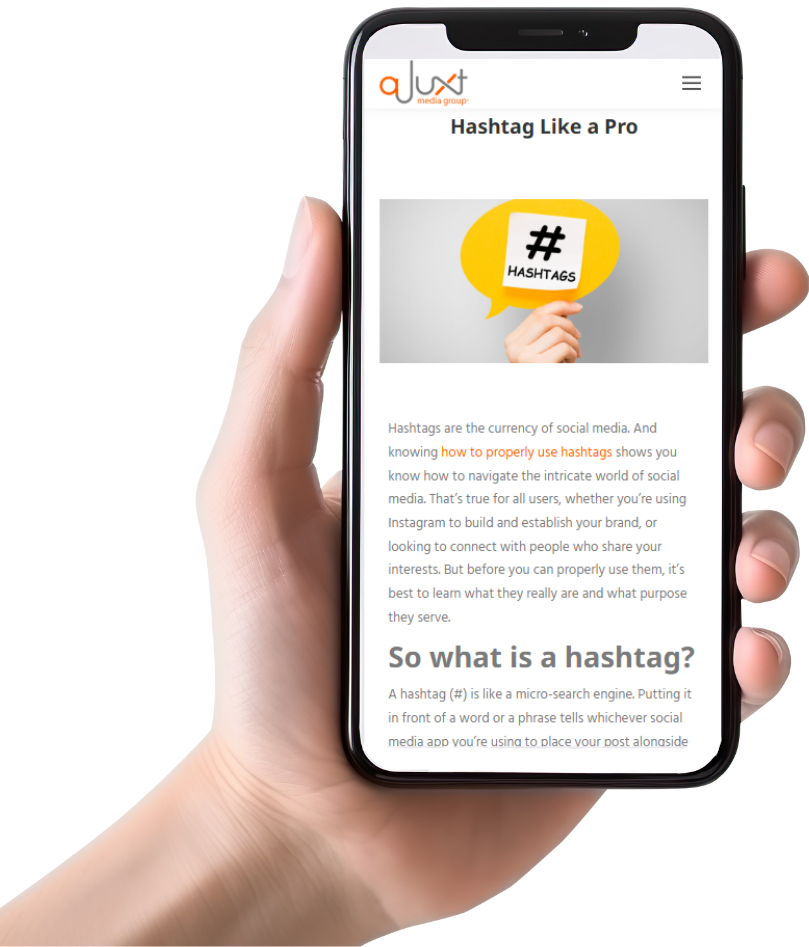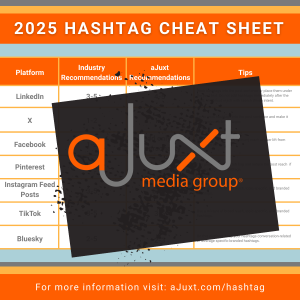Hashtags are the currency of social media. And knowing how to properly use hashtags shows you know how to navigate the intricate world of social media. That’s true for all users, whether you’re using Instagram to build and establish your brand, or looking to connect with people who share your interests. But before you can properly use them, it’s best to learn what they really are and what purpose they serve.
So what is a hashtag?

A hashtag (#) is like a micro-search engine. Putting it in front of a word or a phrase tells whichever social media app you’re using to place your post alongside others using that same hashtag. For example, if you wish to create brand awareness by linking your core content to X, you would write a post like, “We make the best #hamburgers in all of #NYC.”
Any user interested in hamburgers, or looking for anything associated with New York City, can search for those terms on X and come across your post.
The key to using hashtags is recognizing both the art and science behind the process. Sometimes, you’ll use very specific terms aimed to boost and promote your business to get in on the topic your customers want to discuss or learn about. Other times, you’ll use them in a clever or creative way that’s not specifically designed to reach an end result of finding a user via specific topic search.
For example, if you took a picture outside your storefront as heavy rain is falling, you might post that picture to Instagram with the caption, “It’s pouring down rain here, but we’re still open! Come on down and have some freshly baked apple pie! #RainRainGoAway”
Balancing both the targeted, specific hashtags along with the lighthearted ones creates a stronger impression that there’s a human behind your account, and not a faceless advertising machine. That impression makes a huge difference.
Can anyone create a hashtag?
Creating a hashtag is something that anyone can do! All you have to do is have access to social media platforms like X, Instagram or LinkedIn, add the “#” symbol in front of a word or phrase, and include that in your post. You don’t need special software, just a cool idea to spark conversation. However, there are some guidelines you should follow to make your hashtags work more effectively for you. Because a hashtag only gains its true power when many individuals adopt it in their posts, forming a community or a trend around that topic.
Which hashtags should I use?
Identifying the correct hashtags for you and your business is very simple on the surface and very detailed below it. Applying your own consumer-based instincts will show you the right way. If you’re in the business of selling cars, using hashtags before brand names like #FordMustang or #KiaSol makes sense. Depending on what message you’re looking to send, it’s perfectly acceptable to use different hashtags in each post. Perhaps that same car dealership is offering a free oil change to customers who come in to get a trade-in valuation on their vehicle.
“This weekend, West Hills Motors is offering a #FreeOilChange to customers! Come in for a trade-in valuation on your car, and the oil change is on us!”
You know your business and your customers. When it comes to using hashtags, think like them! What would they be looking for in social media? What appeals to them? Tools like the Hashtag Expert app can make finding trending hashtags a snap.
How can my company or brand make an "official" hashtag?
Official hashtags are a powerful tool to enhance brand visibility of your company, brand, event, or campaign because they create a centralized point of interaction for audiences. Brands and companies often designate “official hashtags” on social media platforms like X, Instagram, and Facebook to build a cohesive brand message – or gather all related posts under one easily searchable tag.
If your brand or company decides to create an official hashtag, you’ll want to set guidelines for its use. Will it only be used for certain content or events? Once you are clear on the guidelines for using it, you’ll want to publicly announce that hashtag across all official social media channels and marketing materials. Our brand uses #JuxtAMeetingQuote and #JuxtADay on LinkedIn, this gives us the opportunity to share some behind the scenes social media content with our brand’s audience. Before you decide on using a specific hashtag, make sure that your genius hashtag idea isn’t already being used by anyone else – otherwise, the message will get confused and your efforts will fall flat.
Official hashtags are a systematic and powerful way for brands to rise to the top of specific conversations, guiding public perception and interaction around the brand.
Are hashtags linked together across different platforms?
Unfortunately, no. Hashtags are particular to whatever platform you are on. This means that even if the #Bachelorfinale is trending on both Facebook and X, you’d have to search separately on each platform to follow the conversations, because there’s no cross-platform integration for hashtags.
Understanding this can help tailor your approach on each platform. Utilize hashtags that resonate with users where they are engaging. By knowing that hashtags don’t cross platforms, you can create targeted content that maximizes your reach on each specific social media outlet.
The 6 Commandments of Using a Hashtag
-
- Personality plus. Every brand worth its salt will have its own voice. Your hashtag should resonate with your brand’s identity or the mission of a specific campaign. Choose words or phrases that are closely connected to the topics you cover or the community you engage with. Use this to keep your audience engaged and coming back for more. Do not be afraid to use humor or wit if that plays into your brand. Check out our #JuxtADay tag for some inspiration!
-
- Keep it fresh. Check sites like BrandMentions to make sure that the hashtag is fresh and not last year’s news. A little research is a quick and easy way to make sure which hashtags will get noticed and convey that you have your finger on the pulse of social media.
-
- Throw grammar rules out the window….sort of. A hashtag is a necessity in most Instagram posts to get your full message across. The ability to remove spacing, smash words together, and use numbers instead of spelling gives you more room and space to tweet a complete thought. As in most written communication, it is still important to make sure that the hashtag is spelled correctly. And platforms don’t judge you for capitalization, screen readers for people who are visually impaired work much better if you capitalize each word in the hashtag. #TellASadStoryIn3Words is more readable to a screen reader, but #motivationalmonday won’t raise an objection from a social media platform.
-
- Don’t force the issue. When you are setting up a new tag for branding purposes, it is easy to want to attach it to every post. Avoid this temptation. Start integrating your new hashtag into your social media posts and encourage your followers to use it, but don’t overdo it. It will become stale to your followers really fast, and you will be nullifying that tag’s main purpose of pointing to relevant content.
-
- Know your platform etiquette. When it comes to a post, hashtags should be the cherry on top, not the main ingredient. Stick to current recommendations per post; you do not want them to replace the flow and dialogue of the post itself.
- Monitor and measure your results. Regularly track the hashtag’s performance. See what kind of engagement it garners and be ready to tweak or update it if a better alternative emerges.
When it comes down to it, hashtags are there to make your life easier. When in doubt, take a few deep breaths, do a little research, and just have fun.
Written by Lynsie Slachetka || Chief Executive Juxtaposition Officer & Founder
Hashtag FAQs
Hashtags serve as a critical mechanism for connecting with like-minded individuals, brands and companies who share your interests. Your brand can reach or create new communities – for example, if you’re passionate about creating eco-friendly living homegoods, your brand can strategically post using hashtags like #sustainableliving or #eco-friendly to help you find individuals who share your values. Don’t forget to use analytic tools like Mentionlytics to see who the audiences of various tags are really composed of.
Social trends evolve rapidly, and hashtags are often at the forefront of these changes. Keeping an eye on trending hashtags ensures you’ll stay informed on the latest topics and discussions, which can be crucial for brand development or personal growth.
Hashtags trend when they capture widespread attention and engagement across social media platforms. They tend to fall into certain categories – current events and breaking news, celebrity features, viral videos, memes and challenges like the #icebucketchallenge, large events such as the Oscars or World Cup, holiday marketing campaigns, and social awareness movements.
Social media platforms like X and Instagram have algorithms to identify trending topics based on the volume and velocity of hashtag use, giving priority to those gaining rapid traction.
Understanding the nuances of why hashtags trend can help individuals and brands effectively engage and contribute to larger conversations online.Tools like Toolzu can make finding trending hashtags a snap.
In the world of digital marketing, hashtags and keywords are both tools for categorization and searchability, but they aren’t interchangeable. Hashtags are used mainly on social media to organize conversations around specific topics and make your content discoverable to users searching for that content or those conversations.
Keywords are used mainly on websites, blog posts, and online articles to improve search engine optimization (SEO) rankings. They help users to find content that matches their intent.
On many social media platforms, typing a keyword or a hashtag might bring up similar content. For example, searching for a term with or without the hashtag symbol could yield similar results. This is because platforms often recognize keywords connected to hashtags. But while there’s some overlap, each plays a unique role in online visibility and user engagement.
Hashtags serve as digital anchors that collect all relevant discussions in one accessible stream, especially on platforms like X. Hashtags elevate the visibility of the conference beyond physical walls, reaching global audiences. They allow people who are unable to attend to still participate and engage with the content, expanding the conference’s reach and influence.
When a conference designates an official hashtag, attendees, speakers, and organizers can all contribute to a collective conversation, making it easy to follow updates, session highlights, and attend virtual discussions. Simply searching the hashtag allows anyone to access ongoing dialogue and insights shared in real-time.
By using the official hashtag, participants can effortlessly join discussions, ask questions, and share experiences. This cultivates a sense of community, encouraging networking and interaction not just in person, but also online.
Organizers can monitor the official hashtag to gather feedback, assess popular sessions, and understand attendee sentiment. This data is invaluable for improving future conferences and tailoring content to audience needs.
If you’ve ever scrolled through social media and stumbled upon a hashtag that leaves you scratching your head, you’re not alone. These odd hashtags often pop up, raising the question of their purpose.
Today, many users employ hashtags for creative, humorous, or ironic purposes. It’s a way to inject personality into posts without worrying about traditional grammar rules. Using witty or peculiar phrases like #ILoveEatingPieInTheRain can elicit a smile or prompt curiosity. It’s a playful twist on language that blends commentary with creativity.
Some hashtags gain popularity because they allow participants to partake in broader, often humorous conversations. For example, enormous trends can start from a single quirky idea that resonates with many, like #MondayMotivation or #ThrowbackThursday. These become a digital nod, a shared cultural joke among internet users.
Hashtags function like punctuation in the digital age. They add rhythm and tone to a message, much like a well-placed exclamation mark or question mark. A seemingly nonsensical hashtag can transform a mundane statement into something memorable or impactful.


